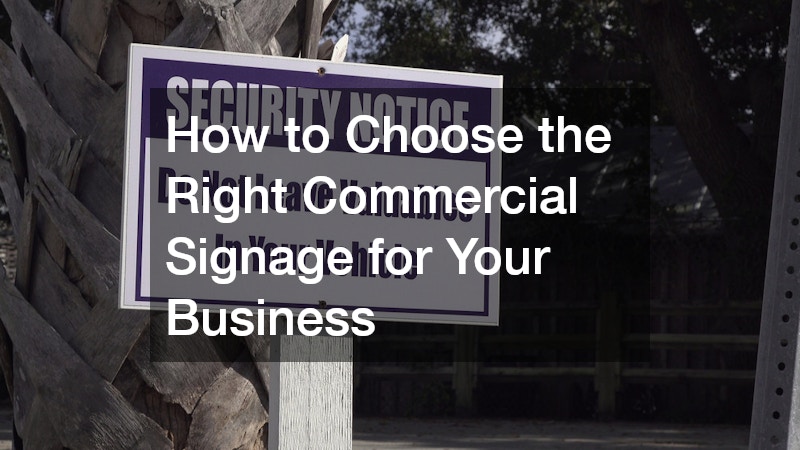First impressions are everything in business and your signage is often the first interaction potential customers have with your brand. Whether mounted on a shopfront or displayed along a busy road, commercial signage plays a vital role in attracting attention, conveying your message and solidifying your brand identity. Selecting the right signage is not merely about aesthetics; it’s a strategic decision that can influence foot traffic, sales and brand recognition.
To ensure your signage makes a strong and lasting impact, it’s essential to understand the various factors that contribute to an effective choice.
Understand Your Brand Identity
Before you even begin evaluating material, size or lighting, you must have a clear understanding of your brand identity. This includes knowing your core values, tone of voice, logo design and colour palette. Consistency in these elements helps customers recognise your business instantly. The signage you choose should align seamlessly with your branding, reinforcing your message and building trust with your audience. For instance, a luxury boutique might opt for elegant, minimalist signage with metallic finishes, whereas a vibrant café could benefit from bold colours and playful typography. Your commercial signage should reflect the overall character of your business and target market.
Consider Visibility & Readability
No matter how well-designed a sign is, it won’t serve its purpose if it’s hard to read or poorly positioned. Visibility is paramount. The size of the sign should correspond to the viewing distance and the speed at which people will pass by. A sign intended for drivers needs larger fonts and more concise messaging compared to one targeting pedestrians. Font choice also matters—avoid overly stylised or script fonts that may be difficult to read at a glance. Colour contrast between text and background enhances readability, especially in low-light conditions. Additionally, think about the height and angle at which the sign will be mounted to maximise its effectiveness in attracting attention.
Select the Right Materials for Longevity
Commercial signage must be durable enough to withstand environmental conditions specific to your location. UV exposure, wind, rain and humidity can all take a toll on signage materials. Aluminium is a popular choice due to its rust resistance and lightweight nature. Acrylic offers a sleek, glossy finish ideal for indoor applications. PVC foam boards, on the other hand, are budget-friendly and suitable for short-term promotions. Choosing materials that align with your desired lifespan and location—whether indoor or outdoor—will ensure your signage maintains its appearance and effectiveness over time.
Evaluate Lighting Options
Illumination can dramatically enhance the visibility of your signage, particularly in the evenings or during gloomy weather. Options range from backlit panels and LED channel letters to spotlighted signs. Illuminated signage not only grabs attention but also ensures your brand is visible around the clock. However, lighting choices should be both practical and stylistically in tune with your business. A 24-hour convenience store, for example, may benefit from bright, energy-efficient LEDs, while a boutique hotel might opt for subtle ambient lighting that conveys sophistication. Always consult local regulations and energy consumption considerations when finalising lighting elements.
Know the Legal Requirements & Council Regulations
Compliance is a crucial part of the signage process. Local councils often have strict guidelines around the size, placement and illumination of signs. These regulations exist to maintain public safety, minimise visual clutter and protect heritage areas. Before committing to a design or location, check your local council’s signage code. This will help you avoid costly alterations or removal orders down the line. It’s also wise to work with a signage provider who understands local rules and can assist with applications and permits as needed.
Balance Aesthetics & Functionality
While visual appeal is essential, commercial signage must also serve its primary function—to communicate your business’s message clearly and effectively. Striking the right balance between aesthetics and functionality can be challenging but rewarding. A beautiful sign that fails to provide essential information, like opening hours or contact details, is not serving your business well. Consider the user experience from a customer’s point of view. What do they need to know and how can that information be delivered quickly and memorably? Combining good design principles with practical messaging ensures your signage is both attractive and informative.
Work with Reputable Signage Experts
Choosing a reliable and experienced signage company can make the entire process smoother and more effective. From design consultation and material selection to compliance and installation, a reputable provider brings technical knowledge and creative insight to your project. Be sure to review portfolios, ask for client testimonials and confirm their understanding of your industry’s unique needs. The right partner will guide you through each stage and help create signage that enhances your brand’s presence.
Invest in Signage That Works as Hard as You Do
Commercial signage is more than just a label—it is a strategic tool that can elevate your business and strengthen your brand. From boosting visibility and reinforcing identity to complying with regulations and ensuring longevity, every decision you make contributes to the final result. Investing in high-quality, well-planned commercial signage is not just about making a good first impression. It’s about making a lasting one. With careful consideration and the help of industry professionals, your signage can become one of your most powerful marketing assets.

